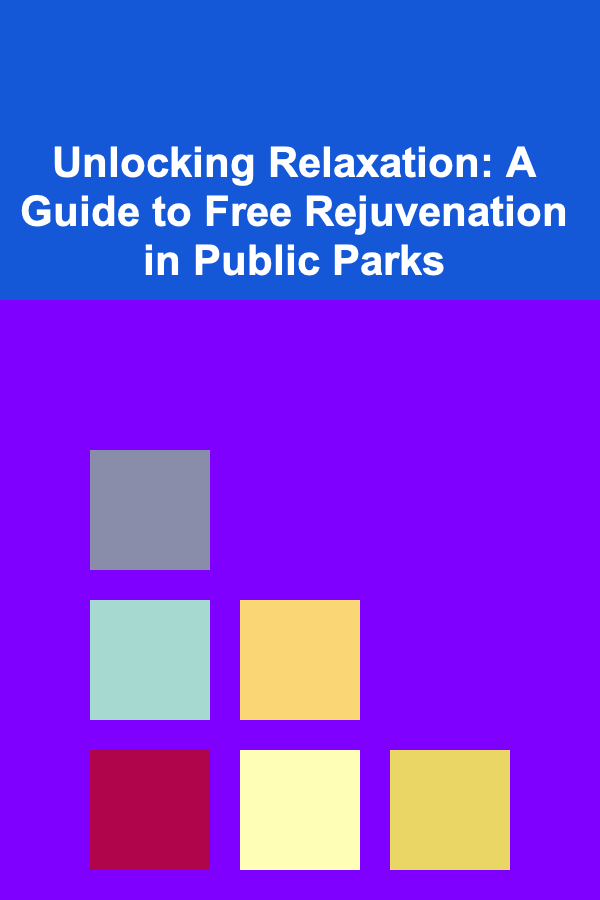
Unlocking Relaxation: A Guide to Free Rejuvenation in Public Parks
ebook include PDF & Audio bundle (Micro Guide)
$12.99$5.99
Limited Time Offer! Order within the next:

In today's fast-paced world, stress and anxiety have become unwelcome companions in our daily lives. The constant barrage of information, demands, and expectations can leave us feeling drained, overwhelmed, and disconnected from ourselves and the natural world. However, amidst the concrete jungles and digital distractions, lies a readily accessible oasis of tranquility: the public park. Often overlooked as mere green spaces, these parks offer a wealth of opportunities for free relaxation and rejuvenation, serving as vital resources for mental, physical, and emotional well-being. This comprehensive guide will explore the myriad ways you can leverage public parks to cultivate relaxation and enhance your overall quality of life, all without spending a dime.
The Science Behind Nature's Calming Effect
Before delving into practical strategies, it's crucial to understand the scientific basis for why spending time in nature, particularly in parks, is so beneficial. Research in environmental psychology and neuroscience has consistently demonstrated a strong link between exposure to nature and improved mental and physical health. Several key mechanisms are at play:
- Stress Reduction: Studies have shown that even short periods of time spent in nature can significantly reduce levels of cortisol, the body's primary stress hormone. The sights, sounds, and smells of nature activate the parasympathetic nervous system, which is responsible for promoting relaxation and reducing heart rate and blood pressure.
- Attention Restoration Theory (ART): Developed by Kaplan and Kaplan, ART suggests that natural environments allow our directed attention, which is easily fatigued by modern life, to rest and recover. Instead, we engage our involuntary attention, which is effortless and restorative. This leads to improved focus, creativity, and problem-solving abilities.
- Increased Positive Emotions: Exposure to nature has been linked to increased feelings of joy, awe, and gratitude. The beauty and complexity of natural landscapes can evoke a sense of wonder and perspective, helping us to feel more connected to something larger than ourselves.
- Vitamin D Synthesis: Spending time outdoors, particularly in sunlight, allows our bodies to synthesize Vitamin D, an essential nutrient that plays a crucial role in bone health, immune function, and mood regulation. Vitamin D deficiency is common, and regular exposure to sunlight in parks can help to address this issue.
- Physical Activity: Parks provide opportunities for various forms of physical activity, from walking and jogging to cycling and playing sports. Physical activity releases endorphins, which have mood-boosting and pain-relieving effects. Even gentle exercise in a natural setting can have profound benefits.
- Improved Air Quality: Parks often have better air quality than urban environments, with trees acting as natural filters that remove pollutants from the air. Breathing cleaner air can improve respiratory health and reduce the risk of cardiovascular disease.
Transforming Your Park Visit into a Relaxation Ritual
While simply being in a park can be beneficial, consciously incorporating relaxation techniques can amplify the positive effects. Here's a comprehensive guide to transforming your park visit into a rejuvenating ritual:
1. Mindful Walking: A Journey of Presence
Mindful walking involves paying attention to the present moment as you walk, noticing the sensations in your body, the sights and sounds around you, and the rhythm of your breath. It's a simple yet powerful practice that can help to calm the mind and reduce stress. Here's how to practice mindful walking in a park:
- Find a Quiet Path: Choose a less crowded path in the park where you can walk without being constantly interrupted. A trail through a wooded area or along a stream can be particularly conducive to mindful walking.
- Focus on Your Breath: Begin by bringing your awareness to your breath. Notice the sensation of the air entering and leaving your body. You can count your breaths if it helps you to focus.
- Engage Your Senses: Pay attention to the sensations in your body as you walk. Notice the feeling of your feet on the ground, the movement of your arms, and the way your body feels in motion. Also, actively engage your senses: listen to the birdsong, feel the breeze on your skin, notice the colors of the flowers, and smell the earthy scent of the trees.
- Let Go of Thoughts: As you walk, your mind will inevitably wander. When you notice your thoughts drifting, gently redirect your attention back to your breath or your senses. Don't judge yourself for having thoughts; simply acknowledge them and let them go.
- Adjust Your Pace: You can walk at a normal pace or slow down your walking to make the practice even more deliberate. The key is to maintain a mindful awareness of your body and your surroundings.
- Observe Without Judgment: As you walk, observe the world around you without judgment. Notice the beauty of the natural world without getting caught up in analyzing or criticizing it. Simply appreciate the present moment as it is.
2. Nature Meditation: Connecting with the Earth
Nature meditation involves using the natural environment as a focal point for your meditation practice. Instead of focusing on your breath or a mantra, you direct your attention to the sights, sounds, and sensations of nature. This can be a deeply grounding and restorative experience. Here's how to practice nature meditation:
- Find a Comfortable Spot: Choose a comfortable place to sit or lie down in the park. A grassy area under a tree or a bench overlooking a lake can be ideal. Make sure you're in a relatively quiet location where you won't be disturbed.
- Ground Yourself: Before you begin, take a few deep breaths and consciously ground yourself in the present moment. Feel the earth beneath you, and imagine yourself drawing energy from the earth.
- Engage Your Senses: Close your eyes and listen to the sounds of nature. Notice the birdsong, the rustling of leaves, the sound of the wind. Then, open your eyes and observe the visual details of your surroundings. Notice the colors, shapes, and textures of the plants, trees, and sky. Finally, pay attention to the sensations in your body. Feel the warmth of the sun on your skin, the breeze on your face, and the coolness of the earth beneath you.
- Choose a Focal Point: You can choose a specific element of nature as your focal point. This could be a single leaf, a flower, a tree, or a body of water. Focus your attention on this object and observe it with curiosity and wonder.
- Allow Thoughts to Pass: As with any meditation practice, your mind will inevitably wander. When you notice your thoughts drifting, gently redirect your attention back to your chosen focal point or to your senses.
- Practice Gratitude: Take a moment to express gratitude for the beauty and abundance of the natural world. Appreciate the simple gifts of nature and the opportunity to connect with them.
3. Forest Bathing (Shinrin-Yoku): Immersing Yourself in the Atmosphere
Forest bathing, or Shinrin-Yoku, is a Japanese practice that involves immersing yourself in the atmosphere of the forest. It's about consciously connecting with nature through all five senses and allowing the forest to soothe and heal you. Unlike hiking or brisk walking, forest bathing is a slow, contemplative activity that emphasizes presence and connection. Here's how to practice forest bathing:
- Leave Your Expectations Behind: The key to forest bathing is to let go of any expectations and simply be present in the moment. Don't try to accomplish anything or reach any particular destination. Just allow yourself to wander and explore.
- Engage All Your Senses: As you walk through the forest, consciously engage all your senses. Listen to the sounds of nature, smell the earthy scents of the trees and plants, touch the bark of the trees, and taste the fresh air. Look closely at the details of the forest, from the tiny insects crawling on the leaves to the towering trees reaching for the sky.
- Breathe Deeply: Practice deep breathing exercises to fill your lungs with the fresh, clean air of the forest. The phytoncides released by trees have been shown to boost the immune system and reduce stress.
- Pause and Reflect: Take time to pause and reflect on your experiences. Sit quietly by a stream, lie down in a meadow, or simply lean against a tree. Allow yourself to feel the peace and tranquility of the forest.
- Connect with Nature: Find ways to connect with nature on a deeper level. Hug a tree, touch the earth, or dip your feet in a stream. Let yourself feel a sense of connection to the natural world.
- Embrace the Imperfect: Forest bathing is not about achieving a perfect experience. It's about embracing the imperfections of nature and allowing yourself to be present in the moment, regardless of what arises.
4. Creative Expression: Nature as Muse
Parks provide an inspiring backdrop for creative expression. Engaging in artistic activities in nature can be a powerful way to relax, connect with your inner self, and tap into your creativity. You don't need to be a professional artist to benefit from this practice. Here are some ideas:
- Nature Journaling: Bring a notebook and pen and write about your experiences in the park. You can describe the sights, sounds, and smells of nature, reflect on your feelings, or write poems or stories inspired by your surroundings.
- Sketching and Drawing: Sketch or draw the natural elements that you find inspiring. You can draw plants, trees, animals, landscapes, or anything else that catches your eye. Don't worry about creating a perfect masterpiece; just focus on the process of observation and expression.
- Photography: Capture the beauty of the park through photography. Experiment with different angles, lighting, and compositions. Focus on capturing the essence of the natural world.
- Nature Art: Create art using natural materials found in the park. You can create sculptures from twigs and leaves, make mandalas with stones and flowers, or create nature collages. Be mindful of leaving no trace and respecting the environment.
- Music and Sound: Bring a musical instrument and play music in the park. The sounds of nature can be a great source of inspiration. You can also simply listen to the sounds of nature and allow them to inspire your creativity.
5. Simple Pleasures: Rediscovering Joy in the Everyday
Sometimes, the simplest activities can be the most relaxing. Parks offer a perfect setting for rediscovering the joy in everyday activities. Here are some ideas:
- Picnics: Pack a simple lunch and enjoy a picnic in the park. Eating outdoors can be a refreshing and enjoyable experience.
- Reading: Bring a book and find a quiet spot to read. Reading in nature can be a great way to escape from the stresses of daily life.
- Cloud Gazing: Lie down on the grass and watch the clouds drift by. Cloud gazing can be a meditative and relaxing activity.
- People Watching: Find a bench and observe the people around you. People watching can be an interesting and entertaining activity.
- Games and Sports: Play a game of frisbee, throw a ball, or fly a kite. Engaging in playful activities can be a great way to relax and have fun.
- Hammock Relaxation: Bring a portable hammock and relax between two trees. This is a simple, comfortable, and incredibly relaxing way to enjoy the park. (Be sure to check park regulations regarding hammocks.)
Creating a Consistent Practice: Integrating Parks into Your Routine
The benefits of park relaxation are most profound when integrated into a consistent routine. Aim to visit a park at least once a week, or even more frequently if possible. Here are some tips for making park visits a regular part of your life:
- Schedule It In: Treat your park visits like any other important appointment and schedule them into your calendar. This will help you to prioritize them and make sure they actually happen.
- Combine It with Other Activities: Integrate park visits into your existing routines. For example, you could walk or bike to the park instead of driving, or you could meet a friend at the park for a workout or a chat.
- Explore Different Parks: Vary your park visits by exploring different parks in your area. This will keep things interesting and allow you to experience a wider range of natural environments.
- Find a Park Buddy: Invite a friend or family member to join you on your park visits. Having a companion can make the experience more enjoyable and help you to stay motivated.
- Be Prepared: Bring everything you need to make your park visits comfortable and enjoyable. This might include water, snacks, sunscreen, a hat, comfortable shoes, and a blanket or chair.
- Embrace the Seasons: Visit the park in all seasons to experience the changing beauty of nature. Each season offers unique opportunities for relaxation and rejuvenation.
Overcoming Barriers: Making Parks Accessible
While public parks are generally accessible, certain barriers can prevent people from fully utilizing them. Understanding these barriers and finding ways to overcome them is crucial for ensuring that everyone can benefit from the restorative power of parks.
- Accessibility Issues: Some parks may not be fully accessible to people with disabilities. Advocate for improved accessibility features such as ramps, paved trails, and accessible restrooms.
- Safety Concerns: Some people may feel unsafe visiting parks, particularly at night or in certain areas. Report any safety concerns to park authorities and consider visiting parks with a friend or during daylight hours. Familiarize yourself with park rules and regulations.
- Lack of Transportation: If you don't have a car, it may be difficult to access parks. Explore public transportation options, such as buses and trains, or consider biking or walking to the park. Advocate for improved public transportation to parks.
- Time Constraints: Busy schedules can make it difficult to find time to visit parks. Try to schedule short park visits into your day, even if it's just for 15-20 minutes. Use your lunch break or a few minutes after work to take a walk in a nearby park.
- Perceived Lack of Interest: Some people may not see the value in visiting parks or may not know what activities they can do there. Try experimenting with different activities until you find something that you enjoy. Read books, articles, or blog posts about the benefits of spending time in nature.
Conclusion: A Pathway to Wellbeing
Public parks are invaluable resources for free relaxation and rejuvenation. By consciously incorporating relaxation techniques such as mindful walking, nature meditation, forest bathing, creative expression, and simple pleasures, you can transform your park visits into powerful tools for managing stress, improving your mental and physical health, and enhancing your overall well-being. Embrace the opportunity to connect with nature, rediscover the joy in everyday activities, and create a consistent practice that integrates parks into your daily routine. The path to a more relaxed and fulfilling life may be just a walk in the park away.

How to Choose the Right Filament Color for Your Project
Read More
How to Develop a Note-Taking System for Virtual Lessons
Read More
How to Increase the Value of Your Investment Property
Read More
How to Sort and Donate Unused Holiday Decorations
Read More
How to Stage a Home with a Small Budget and Big Impact
Read More
How to Implement AI Pathfinding in Unreal Engine
Read MoreOther Products

How to Choose the Right Filament Color for Your Project
Read More
How to Develop a Note-Taking System for Virtual Lessons
Read More
How to Increase the Value of Your Investment Property
Read More
How to Sort and Donate Unused Holiday Decorations
Read More
How to Stage a Home with a Small Budget and Big Impact
Read More